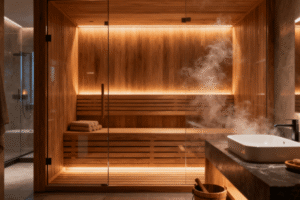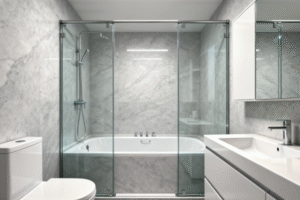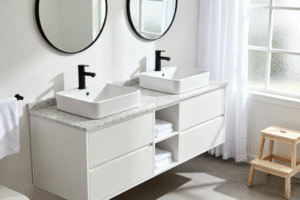The idea sounds relaxing, but many people still hesitate. A home sauna1 feels luxurious, yet costly to start.
A home sauna offers health, relaxation, and privacy, but its value depends on usage frequency, installation quality, and personal lifestyle.
Think about your goals and habits before deciding. Let’s explore the real pros and cons of owning one in 2025.
What Are the Real Benefits of Having a Sauna at Home?
Many people dream of turning daily stress into calm moments. A home sauna helps, but is it worth the setup?
A home sauna improves blood circulation2, helps muscle recovery, supports detoxification, and promotes mental relaxation through heat therapy.
Understanding Sauna Benefits
The physical and mental benefits come from heat exposure. Sweating helps remove toxins and increases endorphins. It can reduce tension after long workdays. For athletes, saunas speed up muscle recovery by improving oxygen flow. Mentally, they offer quiet personal time in a warm, enclosed space, ideal for reflection and rest.
| Benefit | Description |
|---|---|
| Detox | Sweating helps remove impurities and supports the body’s natural cleansing process. |
| Circulation | Heat expands blood vessels, improving blood flow and oxygen delivery throughout the body. |
| Relaxation | Reduces anxiety, eases muscle tension, and helps lower stress hormones like cortisol. |
However, these results depend on consistent use and proper temperature control.
How Much Does a Home Sauna Cost Compared to a Spa Membership?
A home sauna sounds expensive at first glance, but long-term value matters.
A basic home sauna costs between $2,000 and $8,000, while a yearly spa membership3 may exceed $1,500, depending on location.
Cost Comparison and Value
If you use saunas often, owning one saves money after two to three years. The main costs include installation, electricity, and maintenance. Yet, you save travel time and enjoy privacy. Regular users also find that home saunas provide better hygiene control and easier scheduling compared to public spas.
| Option | Average Cost | Notes |
|---|---|---|
| Home Sauna | $2,000–$8,000 | One-time investment covering equipment and setup; long-term ownership with minimal upkeep. |
| Spa Membership | $1,000–$2,000/year | Ongoing payments that include access fees, travel time, and limited privacy. |
For families or wellness lovers, the home option often pays off faster and offers consistent access to relaxation without leaving home.
What Types of Home Saunas Are Available (Infrared, Steam, Traditional)?
Choosing a sauna type can be confusing. Each style provides a unique experience.
Infrared saunas4 heat your body directly, steam saunas use humidity, and traditional saunas rely on high dry heat from stones or heaters.
Sauna Type Breakdown
Infrared models are more energy-efficient and heat up faster. Steam saunas create moist heat, ideal for skin hydration. Traditional saunas mimic classic spa settings with higher temperatures. Each type offers a different sensation and health focus. Infrared models penetrate deeper into muscles, promoting recovery and detox. Steam versions support respiratory health and skin moisture. Traditional saunas provide the strongest heat experience, helping users sweat more intensely in a dry environment.
| Type | Temperature Range | Humidity | Key Feature |
|---|---|---|---|
| Infrared | 120–150°F | Low | Deep tissue heating and faster muscle recovery |
| Steam | 110–120°F | High | Moisture-rich environment for skin and respiratory comfort |
| Traditional | 160–200°F | Low | Intense dry heat that enhances sweating and detoxification |
Your best option depends on personal comfort, health goals, and available home space.
How Do You Choose the Right Sauna Size and Material for Your Home?
Space and material affect comfort, safety, and cost.
The right sauna size5 depends on available space and number of users, while material choice affects durability and heat performance.
Size and Material Selection
Compact models fit one or two people, perfect for small apartments. Large models suit families or villas. Cedar wood6 is preferred for its aroma, natural oils, and strong resistance to moisture and decay. Hemlock and spruce are also durable and give a lighter, modern look, making them suitable for both indoor and outdoor setups. The choice of size and wood type not only affects comfort but also impacts heat retention and maintenance needs over time.
| Size | Capacity | Best For |
|---|---|---|
| 1–2 person | Small apartments | Individuals or couples seeking compact relaxation |
| 3–4 person | Medium homes | Families who want shared wellness time |
| 5+ person | Large villas | Group or resort-style sauna experiences |
A quality build ensures safety, energy efficiency, and long-term satisfaction. When combined with good insulation and ventilation, it enhances both comfort and sauna lifespan.
Does a Home Sauna Increase Property Value or Appeal to Buyers?
People often wonder if it’s an investment or just a luxury.
A well-installed sauna can boost property appeal7 and increase resale value8 by 2–5%, especially in cold regions or luxury markets.
Sauna and Real Estate Appeal
Buyers see saunas as wellness features that reflect a healthy and luxurious lifestyle. Homes with built-in spas or wellness rooms often sell faster because they appeal to comfort-focused buyers. However, poor installation, outdated models, or unsafe wiring can reduce property value and make maintenance costs seem higher. The effect also depends on location — in colder regions or high-end urban markets, a sauna adds more perceived value than in warmer climates.
| Factor | Impact |
|---|---|
| Design Integration | Increases appeal and enhances home aesthetics |
| Energy Efficiency | Improves valuation by lowering long-term costs |
| Maintenance Needs | Affects buyer perception of convenience and upkeep |
In resort-style homes, a sauna can be the highlight, giving the property a premium, wellness-oriented edge that attracts both investors and lifestyle buyers.
What Are the Health Risks or Precautions of Using a Sauna at Home?
Even wellness tools have risks if used wrongly.
Excessive heat exposure9 or dehydration can cause dizziness, especially for those with heart or blood pressure issues.
Using Saunas Safely
It’s important to stay hydrated and limit sessions to 15–20 minutes. Pregnant women and people with medical conditions should consult doctors before using any sauna. Always allow your body to cool down naturally after each session. It’s also wise to avoid alcohol or heavy meals beforehand, as they can increase dehydration risk. Listening to your body and stopping immediately if you feel dizzy or weak is key to safe sauna use.
| Risk | Prevention |
|---|---|
| Dehydration10 | Drink plenty of water before and after each session to maintain fluid balance |
| Overheating | Limit time inside, step out if feeling lightheaded, and ensure proper ventilation |
| Heart Strain | Avoid extreme temperatures and seek medical advice if you have cardiovascular conditions |
Used responsibly, the health benefits far outweigh the risks. With mindful practice, a home sauna remains a safe and rewarding wellness habit.
How Difficult Is It to Install and Maintain a Home Sauna?
Ease of setup depends on model and home design.
Prefab saunas11 are simple to install in a few hours, while custom-built12 ones may require electricians and ventilation work.
Installation and Care
Modern saunas often arrive pre-wired and require only a proper electrical connection, making installation relatively simple for most homeowners. Regular maintenance is essential to keep the sauna safe and efficient. This includes cleaning benches, checking heaters, inspecting ventilation, and ensuring all electrical components remain in good condition. Neglecting maintenance can reduce sauna lifespan and increase the risk of malfunctions or fire hazards.
| Task | Frequency | Purpose |
|---|---|---|
| Cleaning | Weekly | Maintain hygiene and prevent mold or bacteria growth |
| Ventilation Check | Monthly | Ensure airflow is sufficient for safe operation |
| Heater Inspection | Annually | Confirm heaters are functioning efficiently and safely |
Choosing professional installers is highly recommended to guarantee proper setup, comply with safety codes, and protect warranties.
Which Is Better: Building a Sauna Yourself or Buying a Prefabricated One?
DIY might seem cheaper, but it’s not always simpler.
Prefab saunas save time and ensure safety, while DIY builds allow customization but require skills and permits.
DIY vs. Prefab Decision
DIY saunas offer creative control over design and layout, allowing customization to fit unique home spaces or aesthetic preferences. However, building one yourself carries risks, such as poor insulation, incorrect wiring, or uneven heat distribution, which can lead to inefficiency or safety hazards. Prefabricated kits, on the other hand, are professionally tested, easy to assemble, and often come with warranties and support. They provide consistent performance and reduce the risk of costly mistakes.
| Option | Pros | Cons |
|---|---|---|
| Prefab | Quick assembly, safe operation, includes warranty and support | Limited customization options |
| DIY | Fully flexible design and layout, personal satisfaction | Risky for beginners, potential safety and efficiency issues |
For most homeowners, choosing a prefabricated sauna offers the best balance between convenience, safety, and long-term value.
Can a Home Sauna Save Money in the Long Term?
At first, it feels like an expensive treat.
Home saunas reduce recurring spa costs13, improve health, and can add property value, making them cost-effective over time.
Long-Term Financial View
Savings come from reduced spa visits, less travel time, and improved personal health, which can lower medical expenses over time. Some insurance plans or wellness programs even offer support or incentives for at-home wellness equipment. Additionally, frequent use enhances mental well-being, reduces stress, and encourages a consistent self-care routine, making the sauna a practical and rewarding investment.
| Cost Type | Home Sauna | Spa Membership |
|---|---|---|
| Upfront | High one-time cost for equipment and installation | Low initial fee but recurring payments |
| Long-Term | Low maintenance and energy costs compared to ongoing fees | High cumulative cost over years |
| Overall Value | Higher value due to convenience, privacy, and health benefits | Lower value due to continuous expense and limited access |
If you use it weekly, a home sauna quickly becomes a smart financial and wellness investment.
What Are the Best Home Sauna Brands and Manufacturers to Consider in 2025?
Brand quality determines safety and comfort.
Top 2025 sauna manufacturers include Holie, Sunlighten, Almost Heaven, and Finnleo, each known for design, energy efficiency14, and reliability.
Trusted Sauna Brands
Holie, for example, offers customizable, durable saunas suitable for both modern homes and luxury resorts. Top manufacturers provide warranties, reliable insulation, and eco-friendly materials, ensuring long-term performance and safety. When selecting a brand, consider factors such as available sizes, energy efficiency, design options, and the quality of after-sales support to match your specific home setup and wellness goals.
| Brand | Origin | Highlight |
|---|---|---|
| Holie | China | One-stop wellness solution with customizable options and reliable support |
| Sunlighten | USA | Advanced infrared technology for deep tissue heating and energy efficiency |
| Finnleo | Finland | Traditional craftsmanship with high-quality wood and classic design |
| Almost Heaven | USA | Cedar-built outdoor saunas offering durability and natural aroma |
Choose your sauna brand carefully based on warranty, size, energy efficiency, and after-sales service to ensure satisfaction and longevity.
How Energy Efficient Are Modern Home Saunas?
Energy use is a key concern for modern homeowners.
New saunas use low-wattage heaters, smart timers, and better insulation to reduce electricity bills by up to 30%.
Saunas and Energy Savings
Infrared models are the most energy-efficient, consuming less power per session while providing deep tissue heat. Steam and traditional saunas use more electricity due to higher temperatures or water vapor generation. Additional energy-saving features such as insulated doors, LED lighting, programmable timers, and smart thermostats further reduce electricity consumption and operating costs. Proper insulation is critical, as it keeps heat inside, shortens heating time, and lowers monthly energy bills.
| Sauna Type | Power Use (kWh/hour) | Efficiency |
|---|---|---|
| Infrared | 1.5–2.5 | High, uses direct heat efficiently |
| Steam | 3–5 | Medium, requires water heating and ventilation |
| Traditional | 6–8 | Low, high temperatures increase energy use |
Good insulation and smart features make a noticeable difference in monthly energy costs and overall sauna efficiency.
Is a Home Sauna a Good Investment for Wellness and Lifestyle?
Many homeowners now view saunas as lifestyle essentials.
A home sauna enhances daily wellness15, improves recovery, supports relaxation, and increases living comfort, making it both a health and lifestyle upgrade.
Living Better with a Sauna
Regular use of a home sauna builds healthier daily routines, aids muscle recovery, and improves sleep quality. In 2025’s fast-paced life, having a personal wellness space is increasingly valuable for physical and mental well-being. Whether in small apartments or luxury villas, a sauna adapts to different home sizes and lifestyle needs, supporting consistent relaxation and self-care habits.
| Value Aspect | Description |
|---|---|
| Health | Supports detoxification, muscle recovery, and mental relaxation |
| Comfort | Provides a private, quiet zone for stress relief and personal time |
| Longevity | Encourages regular wellness routines and long-term health benefits |
Adding a home sauna aligns comfort, wellness, and smart investment, offering both lifestyle enrichment and potential property value increase.
Conclusion
Buying a home sauna in 2025 is more than a luxury. It’s a lifestyle decision that blends health, value, and daily comfort. With the right design, brand, and maintenance, it becomes an investment that pays off both physically and financially over time.
-
Discover the numerous health and relaxation benefits of a home sauna, making it a worthwhile investment for your well-being. ↩
-
Exploring this link will provide insights into how saunas enhance blood flow, crucial for overall health and recovery. ↩
-
Learn about the benefits and drawbacks of spa memberships to make an informed decision for your wellness routine. ↩
-
Explore the benefits of Infrared saunas to understand how they can enhance your wellness routine and energy efficiency. ↩
-
Understanding sauna size is crucial for comfort and usability. Explore this link to make an informed decision. ↩
-
Cedar wood offers unique benefits like aroma and moisture resistance. Discover why it's the top choice for saunas. ↩
-
Discover how a sauna can enhance your home's attractiveness to potential buyers. ↩
-
Learn about the potential financial benefits of adding a sauna to your property. ↩
-
Understanding the risks of excessive heat exposure can help you use saunas safely and maximize their benefits. ↩
-
Preventing dehydration is crucial for safe sauna use; explore tips to stay hydrated and enjoy your sessions. ↩
-
Explore the advantages of Prefab saunas, including ease of installation and cost-effectiveness. ↩
-
Learn about the complexities and considerations involved in installing custom-built saunas. ↩
-
Learn how investing in a home sauna can lead to significant savings on spa visits and enhance your overall health. ↩
-
Exploring this link will provide insights into how energy-efficient saunas can save you money and enhance your comfort. ↩
-
Discover how incorporating saunas into your routine can significantly boost your daily wellness. ↩






















